- Rent, Lease, or Purchase
- |
October 13, 2016
The Ultimate Guide to Metal Storage Containers
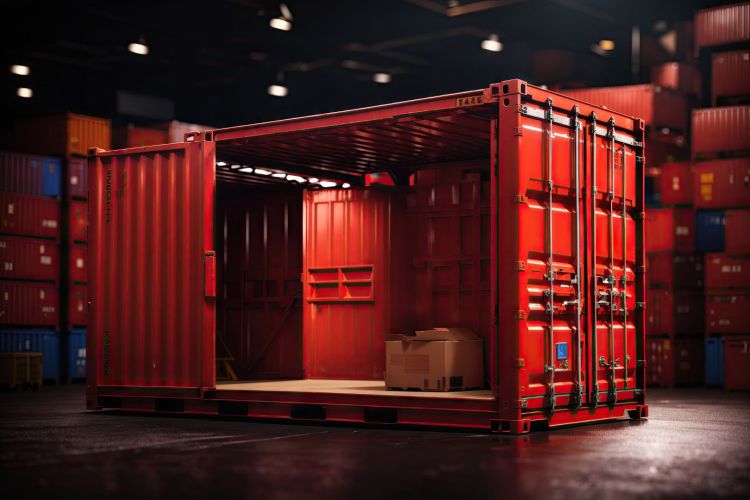
A metal storage container is a multi-functional unit with a wide range of industrial, commercial, and residential applications. From creating additional space for warehousing to building a restaurant, metal storage containers can help you do it all.
You can also use storage containers for:
- Building an apartment complex
- Storing materials, tools, equipment, and machinery at manufacturing sites
- Creating sales offices, interaction areas, retail shops, and display areas
- Starting a container café, coffee shop, or bar
- Accommodating additional inventory and holiday layaway items during peak sale seasons
- Keeping sound and lighting equipment safe during concerts, events, and conferences
- Relief and rehabilitation activities in the event of a disaster
- Vaccination centers, remote medical clinics, and pharmacies
Discover the best storage containers for all kinds of industrial applications.
Understanding the various shipping containers, their uses, and benefits can help you pick the most appropriate storage container units for your applications.
Let's explore a few more important details.
What Is the Difference Between Metal Storage Containers, Shipping Containers, and Conex Boxes?
Metal storage containers, Conex boxes, shipping containers, portable steel containers, sea containers, and cargo containers all refer to the same thing; units that help transport goods across continents.
Shipping containers may go by different names depending on the country, geographical location, or industry they serve.
While they might have a different name, all standard ISO containers have a similar structure made from high-strength Corten steel.
Discover the various industrial applications of metal storage containers.
New vs. Used Storage Containers
The corrugated steel construction of storage containers allows you to extract a service life of approximately 30 years, making both new and used units suitable for a wide range of applications.
New or One-Trip Storage Containers
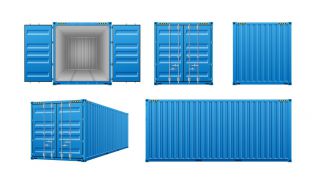
In the United States, the newest type of container you can buy is a 'One-trip' storage container. One-trip units are almost as good as new, with hardly any evidence of wear and tear. If aesthetics is your priority, one-trip containers can be the perfect solution for you.
New containers find applications in building shipping container homes, offices, and restaurants. Along with providing high levels of durability and quality, they come in one single solid color that makes customizations and modifications easy to perform.
In addition, since these containers retire after a single trip, there is less chance of chemical contamination.
Used Storage Containers
Used metal storage containers may have minor dents, blemishes, or surface rust which may slightly diminish the aesthetics. However, these containers offer a budget-friendly alternative to one-trip containers, helping you save as much as 50% of the cost of a new container. You can even hire service and maintenance teams to spruce up these containers.
Note: Used containers undertake several trips. There is a chance they have transported toxic products and may require additional surface treatments. This is why used containers are not a very suitable option for building living spaces.
Maintenance of Shipping Containers
Maintaining your storage containers helps extend their overall service life. These are some quick maintenance tips for new and used shipping containers:
- Cleaning up and painting can help avoid rusting.
- Ensure that your unit is on level ground to prevent water accumulation under or around the container.
- Use container vents and internal circulation systems to prevent moisture accumulation.
- Keep your door hinges well-lubricated.
- Avoid putting extra weight on the roof.
- Make sure the rubber seals on the door are in good condition. Replace the seals if they wear out or strip due to weather.
Which Storage Container Should You Buy?
The two most important considerations for buying a storage container are application and budget.
While new containers may suit certain industries, their prices may reach as high as US$8,500. On the other hand, the cost of a used container falls in the range of $1,000 - $5,000.
Find out more about how much do shipping containers cost.
The prices may vary according to sizes, features, availability, and accessories.
Even though used metal storage containers may seem older, their design helps them last decades. If you want maximum savings and don't mind a few dents and scratches, used containers can be an excellent choice.
What Are the Types of Metal Storage Containers?
Storage container units vary in dimensions, structure, construction, and material. Listed below are a few different types of containers that can be used to store different quantities and different types of products.
Standard Container
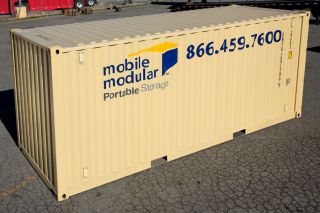
Standard or general-purpose containers, also known as "dry storage containers," are the most common type of containers. They have a fully enclosed construction that protects the content from wind and water.
These containers come in the following standard ISO sizes: 10-foot, 20-foot, 24-foot, and 40-foot.
You can also invest in customizations such as high-security HASP locks, shelving brackets, and pipe racks to improve the container's security and space utilization.
Flat Rack Container
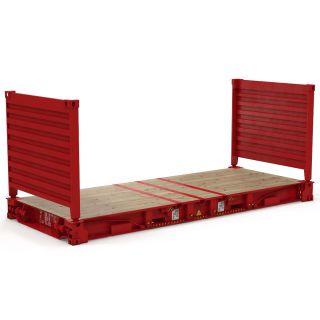
Flat rack storage containers have collapsible walls which you can fold to make a level surface or a 'flat rack' for shipping oversized goods such as heavy vehicles, machinery, and construction equipment. A flat container has highly stable end walls that can secure up to 45 metric tons of cargo.
Open Top Container
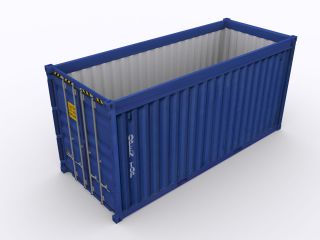
An open-top storage container has a removable top, which makes it suitable for handling over-height cargo. Open top units are also perfect for machinery, equipment, and bulky products that cannot fit through the doors and need cranes for top loading.
Tunnel Container
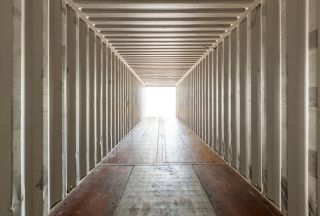
These storage containers have doors on both ends that resemble a tunnel, hence the name 'tunnel containers.' A metal storage tunnel container is perfect for quickly loading and unloading goods.
High Cube Container
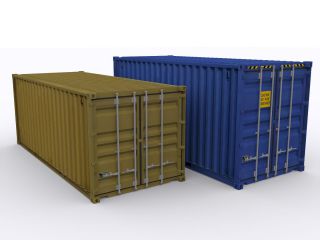
High cube metal storage containers are taller than general-purpose containers. They measure 9ft 6 in or 2.89 meters in height, whereas standard containers are 8ft 6in or 2.59 meters tall. The extra foot increases the storage capacity of high cube containers from 2,350 cubic ft. to 2,694 cubic ft., allowing you to store an additional 344 cubic ft.
A high cube container can store larger machinery, equipment, or automobiles in your storage unit or look for more headspace in your office container. Architects and designers also find the excess height of high cube containers useful when constructing false ceilings, ventilation, and additional space.
Open Side Containers
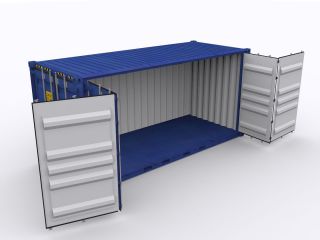
These units have a hinged door that can open on one of the sides too. Open side containers provide more room to enter the container, significantly improving the accessibility. If you have extra-large items and equipment that can't fit through regular doors, you can use open side containers.
Reefer Containers
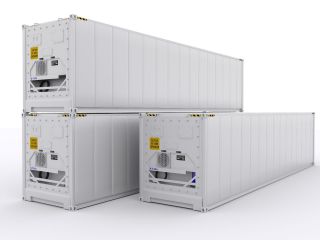
You can purchase a reefer container to store and transport all kinds of temperature-sensitive and perishable cargo such as meats, fruits, and vegetables.
Refrigerated ISO containers or reefers use an external power supply to regulate the temperature inside the container.
Insulated Containers
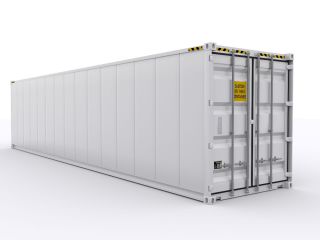
Similar to refrigerated containers, insulated container units have a controlled space that can withstand temperature fluctuations. The construction of an insulated container incorporates a vacuum flask, just like a ‘thermos’ flask, making them ideal for long-distance transportation of pharmaceuticals, chemicals, organs, food, and other biological materials.
Half-Height Containers
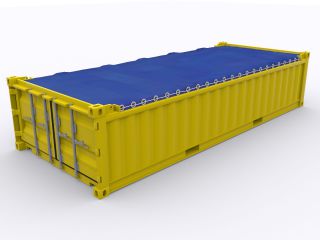
Half-height storage containers have a low center of gravity, which allows them to handle heavier loads better than taller containers. As a result, these containers find application in transporting denser goods such as coal and stones.
Tank Containers
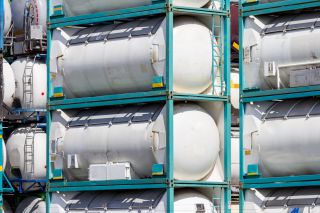
Tankers or tank containers have a strong steel body enhanced with anti-corrosive materials for protecting and transporting all kinds of industrial liquids. For safe operations, transport companies fill the tanker to 80% of its capacity to prevent surging.
Metal Storage Container Dimensions
Storage containers come in the following ISO Sizes: 10', 20', 24', and 40'. All standard storage containers have similar width and height, with varying lengths.
10' Storage Container
The convenient size of 10-foot storage containers helps tackle space limitations at industrial sites. These portable container units can easily fit within small spaces such as a parking space or a driveway.
These units are often used at construction sites, schools, convenience stores, malls, hospitals, and manufacturing plants.
Dimensions:
- Exterior Dimensions: 10’0” L x 8’0” W x 8’6” H
- Interior Dimensions: 9’4” L x 7’8” W x 7’10” H
20' Storage Container
A 20-foot storage container is ideal for small to mid-size commercial storage, fire training facilities, and industrial storage. Companies can use these units to create garages, storage sheds, and moving equipment storage.
Dimensions:
- Exterior Dimensions: 20’0” L x 8’0” W x 8’6” H
- Interior Dimensions: 19’4” L x 7’8” W x 7’10” H
24' Storage Container
The 24-foot container is a great storage solution when 20' containers are too small, and you don't have the budget or space to rent 40-foot units. The additional length of these container boxes helps you store pipes and other large equipment efficiently.
Dimensions:
- Exterior Dimensions: 24’0” L x 8’0” W x 8’6” H
- Interior Dimensions: 23’5” L x 7’8” W x 7’10” H
40' Storage Container
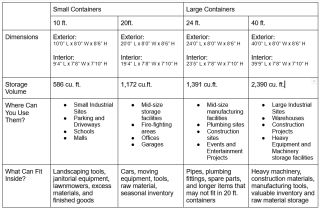
40-foot metal storage container units offer the largest space among all metal storage containers. They are ideal for storing excess inventory, heavy equipment, and machinery for large commercial, material movement, and construction projects. Their high-strength steel body offers maximum durability and keeps your valuable goods safe.
Dimensions:
- Exterior Dimensions: 40’0” L x 8’0” W x 8’6” H
- Interior Dimensions: 39’9” L x 7’8” W x 7’10” H
Read our size guide to learn more about shipping container dimensions.
Renting vs. Buying: Which is Better?
Renting a container is much less costly than buying a container. If your business needs temporary offices or a short-term storage solution, renting a container is the best option. Some companies also provide discounts and lower prices if you rent for a more extended period.
However, you can also purchase storage containers, container offices, and combo units if you have long-term storage needs.
For instance, a retail store might require temporary storage to cater to seasonal variations in demand. On the other hand, if a manufacturing unit is expanding its product storage facilities, buying a container can help reduce overhead costs.
Read more on why renting a shipping container can be a great option.
Conclusion
Metal storage containers offer one of the best options for storage, transportation, and preservation of goods. When picking a suitable container, there are all kinds of options to choose from, ranging from the container type to its condition and size. You can also accessorize your containers with high-security locks, vents, and other accessories to improve their functionality.
Depending upon how long you require container services, you can either rent or buy the most appropriate container for your business.
Mobile Modular Portable Storage is one of the leading suppliers of shipping containers. We offer both rental and purchase options on our portable storage, office, and combo containers.
Frequently Asked Questions
What are steel shipping containers, and how much do they cost?
Steel shipping containers are high-strength, high-volume units that find application in transporting goods across continents. Once these boxes are out of service, they can serve as efficient storage units, offices, warehouses, retail shops, construction equipment sheds, remote clinics, etc.
The prices of shipping containers depend upon various factors such as size, condition, availability, accessories, and customizations. They typically cost somewhere between $1000-$5000.
Where can I buy metal storage containers?
A metal storage container supplier, such as Mobile Modular Portable Storage, can help you select the most appropriate container for your application. If you don't have enough resources for buying a container, renting can be a much more cost-effective option.
What is the difference between a storage container, a shipping container, and a Conex (or Connex) box?
Metal storage containers, Conex boxes, shipping containers, portable steel containers, sea containers, and cargo containers all refer to units that help transport goods across continents. Shipping containers may have different names depending upon the geographical location or industry they serve.
What should I look for in a steel storage container for shipping?
Look for signs of dents, stretches, damage, or rusting that may affect the container's structural integrity. If you plan on transporting or storing temperature-sensitive goods, your container must have a leakproof design to prevent unwanted heat flow.
Related Blogs
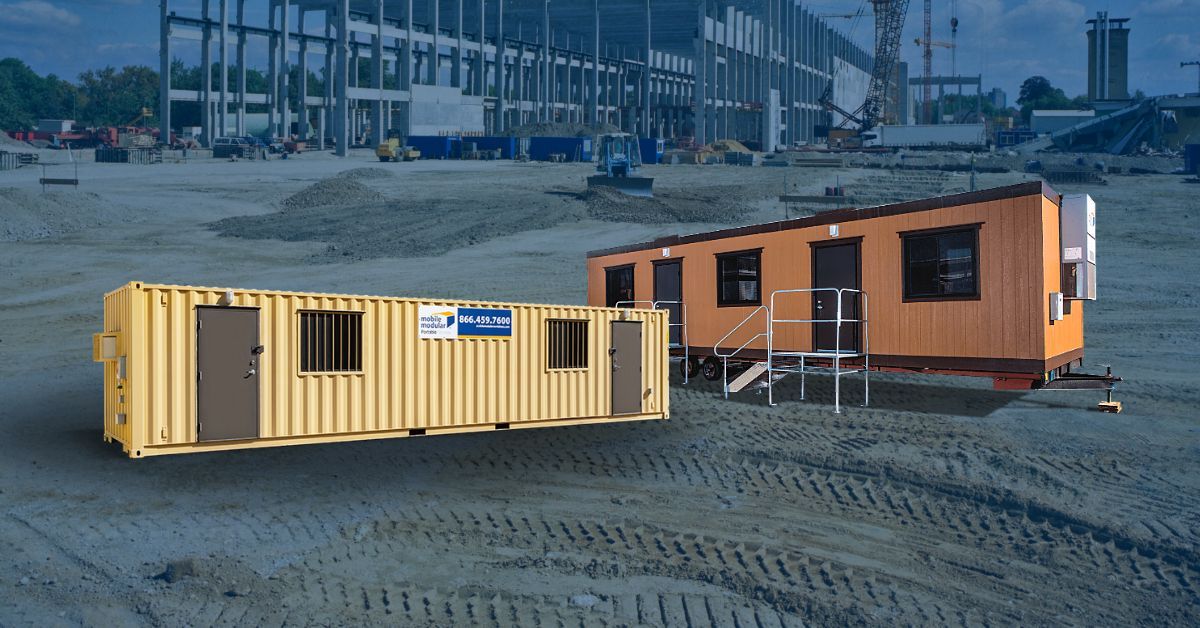
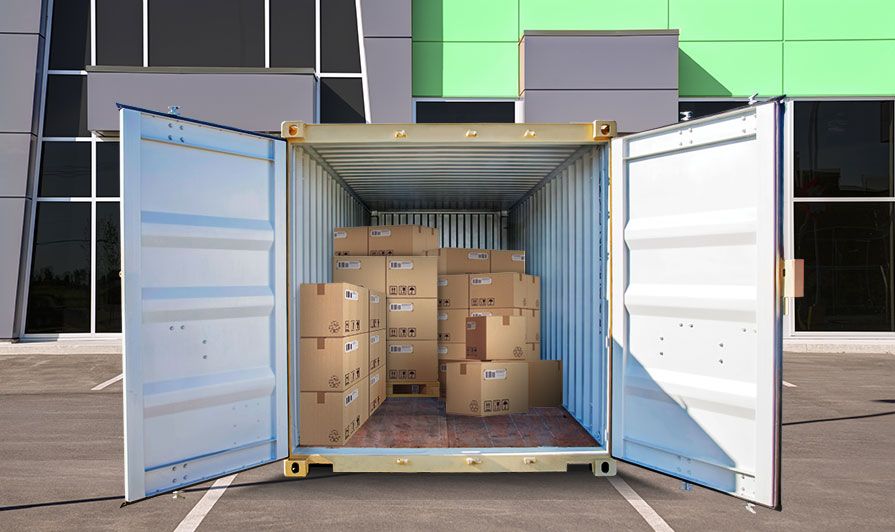

Subscribe to Our Blog
Enter your email address to subscribe to the blog and receive the notification of new posts by email.
Thank You for Subscribing to Our Blog!
Stay tuned for upcoming emails with valuable content that we hope will enhance your experience with our brand.
Both Pardot and mg360 form submissions failed.
